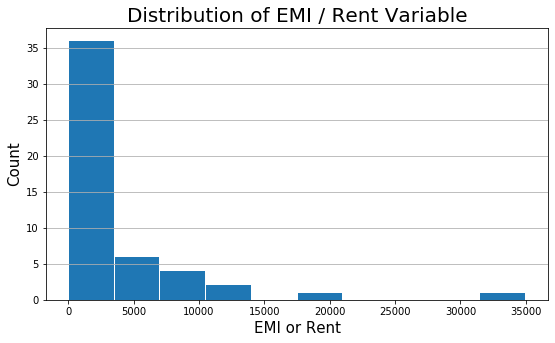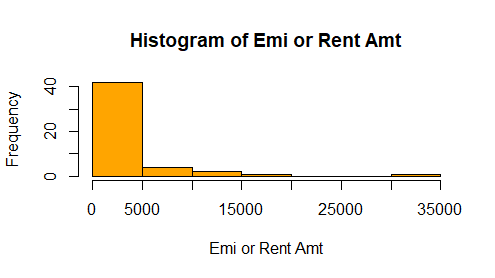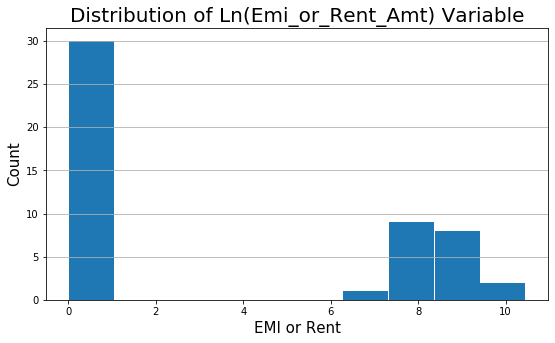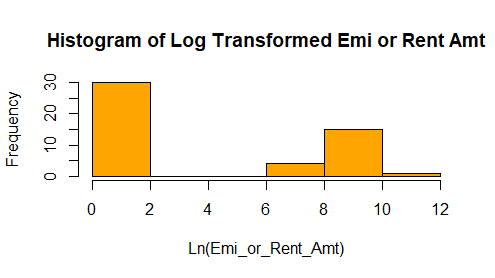In machine learning, we apply Variable Transformation to improve the fit of the regression model on the data. The functions such as Natural Log, Exponential, Square, Square-Root, Inverse, Binning/Bucketing, or some business logic is commonly used to perform variable transformation. In this blog, we will see how a simple variable transformation step can improve the model performance by about 10%.
Multiple Linear Regression Model
In the previous blog, we had built a multiple linear regression model using three variables, Mthly_HH_Income, No_of_Fly_Members, and Emi_or_Rent_Amt. The Adjusted R-Squared of the model is 0.678. Moreover, it was observed that there is skewness in the Emi_or_Rent_Amt variable. Shown below is the histogram plot of the Emi_or_Rent_Amt variable for quick remembrance.
plt.figure(figsize=(9,5))
plt.hist(inc_exp['Emi_or_Rent_Amt'], rwidth = 0.98)
plt.title("Distribution of EMI / Rent Variable", fontsize=20)
plt.xlabel('EMI or Rent', fontsize=15)
plt.ylabel('Count', fontsize=15)
plt.grid(axis='y')
hist(x=inc_exp$Emi_or_Rent_Amt,
main = "Histogram of Emi or Rent Amt",
xlab = "Emi or Rent Amt",
ylab = "Frequency",
col = "orange")
Variable Transformation
From histogram, we see there is skeness in the variable Emi_or_Rent_Amt. I propose we should do a Natural Log transformation of the variable. The log normal functions will scale the variable and make it somewhat normally distributed.
# Log Transformation step
import numpy as np
inc_exp['Ln_Emi_or_Rent_Amt'] = np.log(inc_exp['Emi_or_Rent_Amt'] + 1)
# Histogram
plt.figure(figsize=(9,5))
plt.hist(inc_exp['Ln_Emi_or_Rent_Amt'], rwidth = 0.98)
plt.title("Distribution of Ln(Emi_or_Rent_Amt) Variable", fontsize=20)
plt.xlabel('Ln (Emi_or_Rent_Amt)', fontsize=15)
plt.ylabel('Count', fontsize=15)
plt.grid(axis='y')
inc_exp$Ln_Emi_or_Rent_Amt = log(inc_exp$Emi_or_Rent_Amt + 1)
hist(x=inc_exp$Ln_Emi_or_Rent_Amt ,
main = "Histogram of Log Transformed Emi or Rent Amt",
xlab = "Ln(Emi_or_Rent_Amt)",
ylab = "Frequency",
col = "orange")
Model Performance Comparison
We will compare the model built with & without variable transformation to see the improvement in Adjusted R-Squared model performance measure.
## Multiple Linear Regression Without Transformation
m_linear_mod = sma.ols(formula = "Mthly_HH_Expense ~ Mthly_HH_Income+\
No_of_Fly_Members + Emi_or_Rent_Amt ",
data = inc_exp).fit()
## Multiple Linear Regression With Transformation
m_linear_mod_2 = sma.ols(formula = "Mthly_HH_Expense ~ Mthly_HH_Income+\
No_of_Fly_Members + Ln_Emi_or_Rent_Amt ",
data = inc_exp).fit()
print("Adj. R-Squared WITHOUT Transformation",
m_linear_mod.rsquared_adj.round(4))
print("Adj. R-Squared WITH Transformation",
m_linear_mod_2.rsquared_adj.round(4))
Adj. R-Squared WITHOUT Transformation 0.6781
Adj. R-Squared WITH Transformation 0.7436
## Multiple Linear Regression Without Transformation
m_linear_mod <- lm( Mthly_HH_Expense ~ Mthly_HH_Income
+ No_of_Fly_Members + Emi_or_Rent_Amt,
data = inc_exp )
## Multiple Linear Regression With Transformation
m_linear_mod_2 <- lm( Mthly_HH_Expense ~ Mthly_HH_Income
+ No_of_Fly_Members + Emi_or_Rent_Amt,
data = inc_exp )
cat("Adj. R-Squared WITHOUT Transformation",
summary(m_linear_mod)$adj.r.squared)
cat("Adj. R-Squared WITH Transformation",
summary(m_linear_mod_2)$adj.r.squared)
Adj. R-Squared WITHOUT Transformation 0.6780635
Adj. R-Squared WITH Transformation 0.7435739
Note:
In linear regression, there is no assumption that the explanatory (independent) variable should be normally distributed. However, the model performance is improved significantly by transforming a skewed independent variable and making it normally distributed.
Related reading: Variable Transformation example in Logistic Regression Model
Practice Exercise
We have used only the initial 3 explanatory variables. The variables Highest_Qualified_Member & No_of_Earning_Member has been left as a practice exercise.
Next Blog
In the next blog, we will learn how to predict the estimated value, compute residuals (error), RMSE, and more.
<<< previous blog | next blog >>>
Linear Regression blog series home





Recent Comments